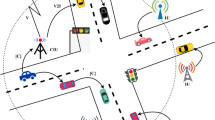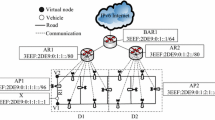Abstract
Today, the media content delivery in intermittent connected networks has become increasingly critical. This paper studies content exchange among mobile commuters in urban transport systems. Our work is inspired by two facts: (1) the commuters in urban transport systems tend to take regular routes to the same place every weekday and their paths exhibit a high degree of temporal and spatial regularities; (2) the rapid development of broadband wireless technologies such as IEEE 802.11n makes fast data transfer possible. We first propose a new disconnection-tolerant network infrastructure, which reinforces the connectivity of intermittent connected mobile commuters and uses store-and-forward routers to increase their encounter opportunity, and in turn achieves efficient media content delivery among them. Then a router-centric prediction method is designed to collect passengers’ historical path information to determine the best delivery scheme. We evaluate the feasibility and the performance of the proposed infrastructure as well as the delivery scheme, using real data set from an urban transport system. The simulation results demonstrate the proposed system is highly practical in terms of the memory usage of routers and the maximum achievable data transfer rate.








Similar content being viewed by others
References
Lyons, G., & Chatterjee, K. (2008). A human perspective on the daily commute: Costs, benefits and trade-offs. Transport Reviews, 28, 181–198.
Chen, W., Guha, R. K., Kwon, T. J., Lee, J., & Hsu, Y. Y. (2011). A survey and challenges in routing and data dissemination in vehicular ad hoc networks. Wireless Communications and Mobile Computing, 11(7), 787–795.
Park, H. S., & Kim, J. D. (2013). Wi-Fi-based modeling and hybrid routing scheme for delay-tolerant public bus network. Wireless Communications and Mobile Computing to appear; doi:10.1002/wcm.2392.
McNamara, L., Mascolo, C., & Capra, L. (2008). Media sharing based on colocation prediction in urban transport. Proceedings of ACM MobiCom, 58–69.
Lathia, N., Smith, C., Froehlich, J., & Capra, L. (2013). Individuals among commuters: Building personalised transport information services from fare collection systems. Pervasive and Mobile Computing, 9(5), 643–664.
Ott, J., & Kutscher, D. A. (2005). Disconnection-tolerant transport for drive-thru internet environments. Proceedings of IEEE INFOCOM, 1849–1862.
Johari, R., Gupta, N., & Aneja, S. (2013). CACBR: Context aware community based routing for intermittently connected network. In Proceedings of the 10th ACM symposium on Performance evaluation of wireless ad hoc, sensor, & ubiquitous networks, pp. 137–140.
Vahdate, A., & Becker, D. (2002). Epidemic routing for partially connected ad hoc networks. Technical Report, CS-200006, Duke University.
Spyropoulos, T., Psounis, K., & Raghavendra, C. (2008). Efficient routing in intermittently connected mobile networks: The multiple-copy case. IEEE/ACM Transactions on Networking, 16(1), 77–90.
Liu, L., Biderman, A., & Ratti, C. (2009). Urban mobility landscape: real time monitoring of urban mobility patterns. In Proceedings of Computers in Urban Planning and Urban Management (CUPUM), 1–16.
Gonzalez, M. C., Hidalgo, C. A., & Barabasi, A. L. (2008). Understanding individual human mobility patterns. Nature, 453, 779–782.
Liu, C., & Wu, J. (2009). An optimal probabilistic forwarding protocol in delay tolerant networks. Proceedings of ACM MobiHoc, 105–114.
Burns, B., Brock, O., & Levine, B.N. (2005). MV routing and capacity building in disruption tolerant networks. Proceedings of IEEE INFOCOM, 398–408.
Paulos, E., & Goodman, E. (2004). The familiar stranger: anxiety, comfort, and play in public places. In Proceedings of the SIGCHI conference on Human factors in computing systems (CHI), 223–230.
Eriksson, J., Balakrishnan, H., & Madden, S. (2008). Cabernet: Vehicular content delivery using wifi. Proceedings of ACM MobiCom, 199–210.
Kriplean, T., Welbourne, E., Khoussainova, N., Rastogi, V., Balazinska, M., Borriello, G., et al. (2007). Physical access control for captured RFID data. IEEE Pervasive Computing, 6(4), 48–55.
Amaral, L. A., Hessel, F. P., Bezerra, E. A., Corrêa, J. C., Longhi, O. B., & Dias, T. F. (2011). eCloudRFID—A mobile software framework architecture for pervasive RFID-based applications. Journal of Network and Computer Applications, 34(3), 972–979.
Vastardis, N., & Yang, K. (2013). Mobile social networks: Architectures, social properties, and key research challenges. IEEE Communications Surveys & Tutorials, 15(3), 1355–1371.
Wang, S., Liu, M., Cheng, X., Li, Z., Huang, J., & Chen, B. (2013). Opportunistic routing in intermittently connected mobile p2p networks. IEEE Journal on Selected Areas in Communications, 31(9), 369–378.
Daraghmi, Y. A., Yi, C. W., & Stojmenovic, I. (2013). Forwarding methods in data dissemination and routing protocols for vehicular ad hoc networks. IEEE Network, 27(6), 74–79.
Jung, S., Lee, U., Chang, A., Cho, D., & Gerla, M. (2007). Bluetorrent: Cooperative content sharing for bluetooth users. Proceedings of IEEE PerCom, 47–56.
LeBrun, J., & Chuah, C. (2006). Bluetooth content distribution stations on public transit. In Proceedings of Workshop on Decentralized Resource Sharing in Mobile Computing and Networking, 63–65.
Paul, S., Yates, R., Raychaudhuri, D., & Kurose, J. (2008). The cache and forward network architecture for efficient mobile content delivery services in the future internet. In Proceedings of innovations in NGN: ITU-T Kaleidoscope Academic Conference on Future Network and Services, pp. 367–374.
Banerjee, N., Corner, M.D., & Levine, B.N. (2007). An energy-efficient architecture for DTN throwboxes. Proceedings of IEEE INFOCOM, 31–40.
Zhao, Y., Chen, M.H., Ammar, M.C., Levine, B.N., & Zegura, E. (2006). Capacity enhancement using throwboxes in DTNs. Proceedings of IEEE MASS, 31–40.
Shu, L., Jiang, H.B., Ma, X.Q., Liu, L.C., Peng, K., Liu, B., Cheng, J., & Xu, Y.B. (2010). Efficient mobile content delivery based on co-route prediction in urban transport. Proceedings of IEEE GLOBECOM, 1–5.
Available: http://www.szmc.net/
Acknowledgments
This work was supported in part by the National Natural Science Foundation of China under Grants 61271226, 61272410, 61202460 and 61471408; by the National High Technology Research and Development Program (“863”Program) of China under Grants 2014AA01A701 and 2015AA011303; by the National Natural Science Foundation of Hubei Province under Grant 2014CFA040; by the China Postdoctoral Science Foundation under Grants 2014M560608; and by the Fundamental Research Funds for the Central Universities under Grant 2015QN073.
Author information
Authors and Affiliations
Corresponding author
Rights and permissions
About this article
Cite this article
Wei, W., Wang, C., Lin, H. et al. A novel networking architecture for mobile content delivery in urban transport systems. Wireless Netw 22, 427–438 (2016). https://doi.org/10.1007/s11276-015-0958-4
Published:
Issue Date:
DOI: https://doi.org/10.1007/s11276-015-0958-4




